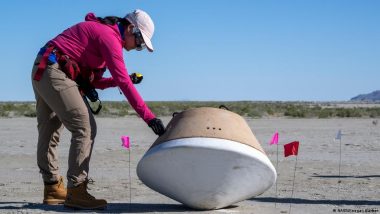After a 7-year round-trip, NASA's OSIRIS-REx will drop asteroid samples to Earth on September 24. We answer your questions.NASA's OSIRIS-REx is a robotic spacecraft that has been on a seven-year mission to collect and return samples from an asteroid called Bennu — billions of kilometers from Earth.
It took more than two years to reach Bennu after OSIRIS-REx launched in 2016. It then spent almost as much time mapping the asteroid, finding a site to scrape, and collecting about 250 grams (8.8 ounces) of the rock. Then it began its journey back towards Earth.
Also Read | Deadly Dam Failures: Cause, Effect and Prevention.
How will the OSIRIS-REx samples return to Earth?
At an altitude of about 250 kilometers (155 miles) from the surface of Earth, OSIRIS-REx will release a capsule carrying the samples over the Great Salt Lake Desert in Utah, US — come "rain or shine," says NASA.
Scientists have been training to recover the capsule and securely transfer the samples to NASA's Johnson Space Center in Houston, Texas.
But that's not the end of OSIRIS-REx. Having released its capsule, it travels on towards a new destination: Apophis, an asteroid once thought to pose a hazardous impact threat to Earth — but not anymore, at least not for the next 100 years.
What is a sample return mission?
These days, sample return missions tend to be robotic. But we have in the past sent humans to collect rocks and soil from space — NASA's Apollo missions did that between 1969 and 1972.
Sample return missions send spacecraft to land on a celestial body — a moon, asteroid or planet — and collect samples of soil, minerals and rock.
The samples are analyzed in laboratories on Earth. But some get stored, too — a lot of the Apollo samples were left sealed and untouched because scientists and engineers figured technology would improve over time, allowing them to conduct different or better experiments in the future.
Why do scientists collect samples from space and what do we learn?
Samples from space tell us about life elsewhere in our solar system and early Earth history. Some scientists, and people in industry, hope that asteroids will become a source of minerals as our earthly resources deplete.
The samples can include atoms, molecules, and complex compounds — even, scientists hope, evidence of water — and, as crazy as it may sound, particles of solar wind or cometary debris.
Who will analyze the samples from Bennu?
NASA says its samples from the asteroid Bennu "will give generations of scientists a window into the time when the sun and planets were forming about 4.5 billion years ago" — and the beginnings of life as we know it today. Bennu is thought to be rich in carbon, a chemical that is essential to life.
While NASA plans to keep 25% of the samples for its own research, it says it will distribute the rest among 200 mission members at 35 institutions around the world. That includes 4% of the samples going to the Canadian Space Agency, because they provided an instrument — a laser altimeter — for the OSIRIS-REx mission.
And 0.5% of the samples will go to the Japanese space agency, the Japan Aerospace Exploration Agency (JAXA) as part of a partnership. It's not exactly quid-pro-quo, however: JAXA has previously shared 10% of its asteroid samples with NASA.
How often have samples been collected from asteroids?
More often than you may think. Aside from the Apollo era moon landings, during which NASA collected about 382 kilograms (842 pounds) of rock and moon soil, Soviet-era Russia conducted three successful robotic missions between 1969 and 1976 to procure about 326 grams of samples (11 ounces).
More recently, JAXA's Hayabusa mission (2003-2010) was the first time humans had brought back samples from a near-Earth object: the asteroid Itokawa. Japan followed that with Hayabusa2, which returned samples from an asteroid called Ryugu in 2020.
And, also in 2020, China's Chang'e 5 mission returned samples from the moon.
Are any sample return missions planned for the future?
Japan's Martian Moons eXploration (MMX) aims to be the first sample return mission to bring back rocks from the Mars region. Scheduled to launch in 2024, MMX aims to investigate the moons of Mars, Phobos and Deimos, and gather information on how they formed, because it's hoped that this will help scientists better understand how the solar system formed. MMX also aims to collect samples from Phobos, the larger of the two moons, and then return to Earth in 2029.
Meanwhile, the European Space Agency and NASA are engaged in a sample return mission from the surface of Mars, which, if all things go to plan, will return to Earth in 2033.
Edited by: Carla Bleiker
(The above story first appeared on LatestLY on Sep 21, 2023 03:00 PM IST. For more news and updates on politics, world, sports, entertainment and lifestyle, log on to our website latestly.com).













 Quickly
Quickly





















